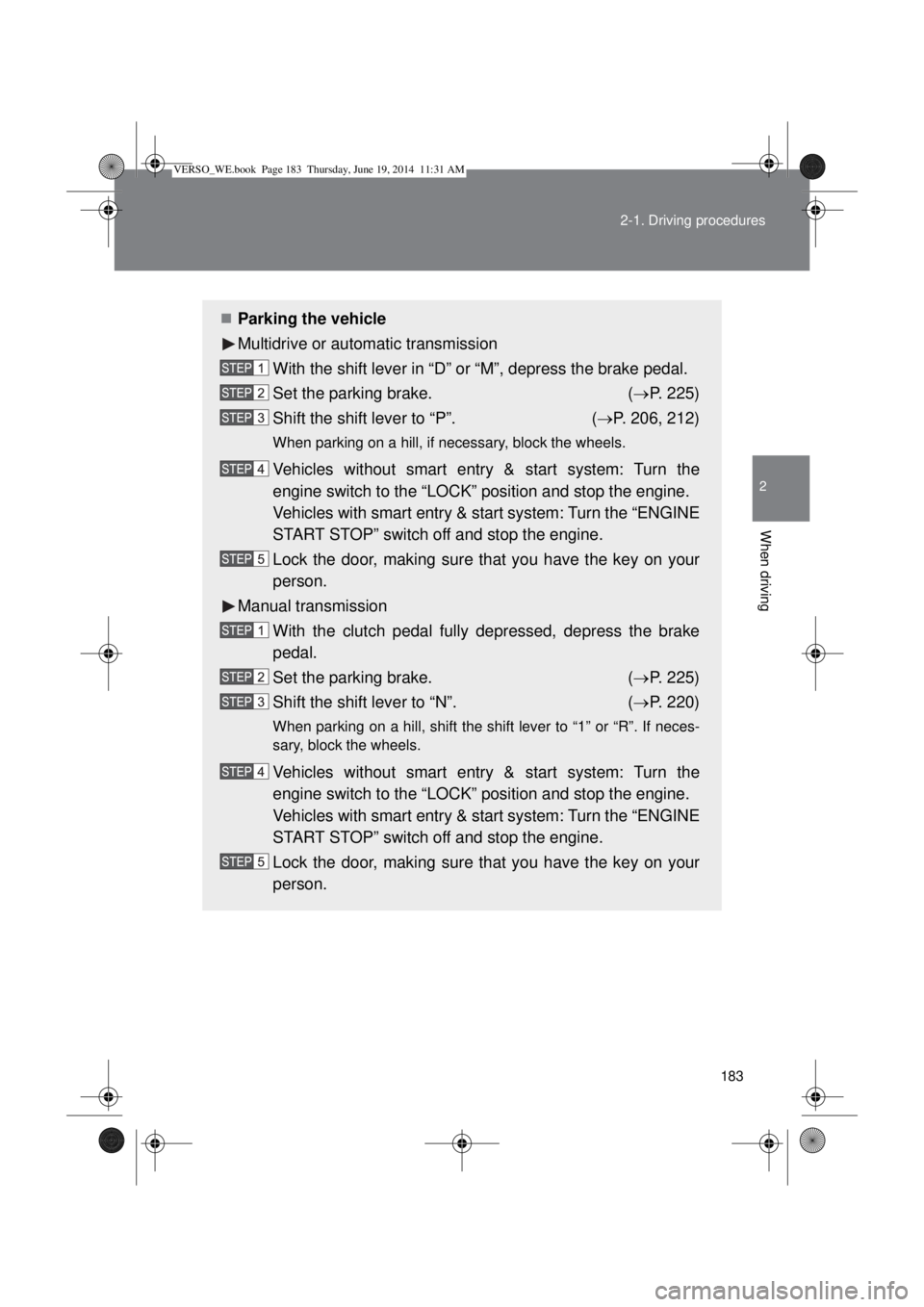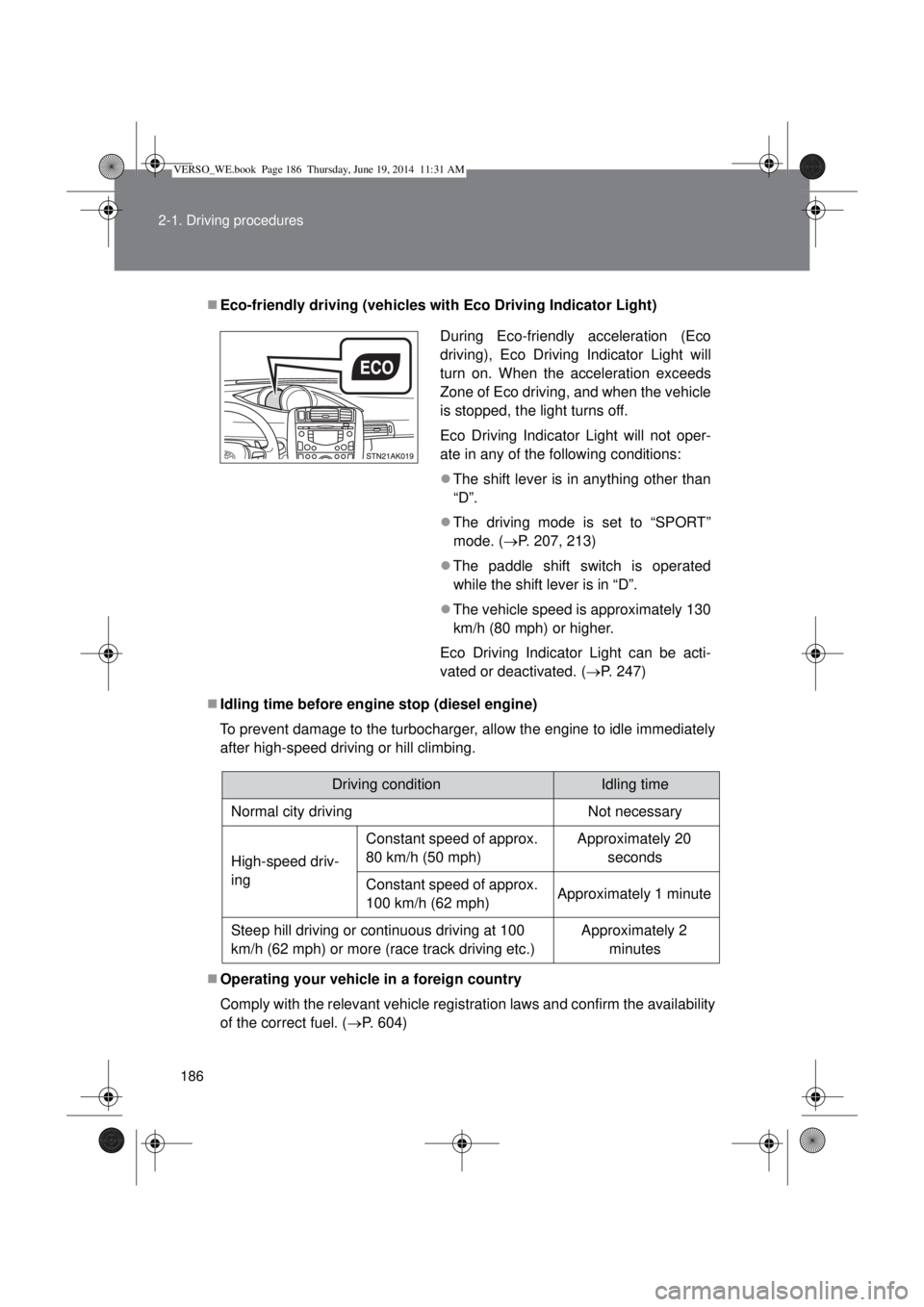Page 178 of 650
178 1-7. Safety information
Vehicles with automatic air conditioning system
“PASSENGER AIRBAG”
indicator
Vehicles without smart entry &
start system: This indicator
light turns on when the airbag
system is on (only when the
engine switch is in the “ON”
position).
Vehicles with smart entry &
start system: This indicator
light turns on when the airbag
system is on (only when the
“ENGINE START STOP”
switch is in IGNITION ON
mode).
Airbag manual on-off switch
VERSO_WE.book Page 178 Thursday, June 19, 2014 11:31 AM
Page 179 of 650
179 1-7. Safety information
1
Before driving
Deactivating the front passenger airbag
Vehicles without smart entry &
start system: Insert the key into
the cylinder and turn to the
“OFF” position.
The “OFF” indicator light turns on
(only when the engine switch is in
the “ON” position).
Vehicles with smart entry & start
system: Insert the mechanical
key into the cylinder and rotate to
the “OFF” position.
The “OFF” indicator light turns on
(only when the “ENGINE START
STOP” switch is in IGNITION ON
mode).
“PASSENGER AIRBAG” indicator information
If any of the following problems occurs, it is possible that there is a malfunc-
tion in the system. Have the vehicle inspected by any authorized Toyota
dealer or repairer, or another duly qualified and equipped professional.
Neither “ON” nor “OFF” comes on.
The indicator does not change when the airbag manual on-off switch is
switched to the “ON” or “OFF” position.
VERSO_WE.book Page 179 Thursday, June 19, 2014 11:31 AM
Page 181 of 650

2When driving
181
2-1. Driving procedures
Driving the vehicle ............ 182
Engine (ignition) switch
(vehicles without smart
entry & start system)....... 196
Engine (ignition) switch
(vehicles with smart
entry & start system)....... 200
Multidrive .......................... 206
Automatic transmission .... 212
Manual transmission......... 220
Turn signal lever ............... 224
Parking brake ................... 225
Horn .................................. 227
2-2. Instrument cluster
Gauges and meters .......... 228
Indicators and warning
lights ............................... 233
Multi-information display ... 239
2-3. Operating the lights and
wipers
Headlight switch ............... 251
Fog light switch ................. 258
Windshield wipers and
washer ............................ 259
Rear window wiper and
washer ............................ 2642-4. Using other driving systems
Cruise control.................... 265
Speed limiter ..................... 269
Toyota parking
assist-sensor .................. 272
Stop & Start system .......... 280
Driving assist systems ...... 287
Hill-start assist control....... 293
2-5. Driving information
Cargo and luggage ........... 295
Winter driving tips ............. 298
Trailer towing
(except Morocco) ............ 302
VERSO_WE.book Page 181 Thursday, June 19, 2014 11:31 AM
Page 182 of 650

182
2-1. Driving procedures
Driving the vehicle
The following procedures should be observed to ensure safe driv-
ing.
Starting the engine (P. 196, 200)
Driving
Multidrive or automatic transmission
With the brake pedal depressed, shift the shift lever to “D”
or “M”. (P. 206, 212)
Release the parking brake. (P. 225)
Gradually release the brake pedal and gently depress the
accelerator pedal to accelerate the vehicle.
Manual transmission
With the clutch pedal fully depressed, shift the shift lever to
“1”. (P. 220)
Release the parking brake. (P. 225)
Gradually release the clutch pedal. At the same time, gently
depress the accelerator pedal to accelerate the vehicle.
Stopping
Multidrive or automatic transmission
With the shift lever in “D” or “M”, depress the brake pedal.
If necessary, set the parking brake.
When the vehicle is stopped for an extended period of time, shift
the shift lever to “P” or “N”. (P. 206, 212)
Manual transmission
With the clutch pedal fully depressed, depress the brake
pedal.
If necessary, set the parking brake.
When the vehicle is stopped for an extended period of time, shift
the shift lever to “N”. (P. 220)
VERSO_WE.book Page 182 Thursday, June 19, 2014 11:31 AM
Page 183 of 650

183 2-1. Driving procedures
2
When driving
Parking the vehicle
Multidrive or automatic transmission
With the shift lever in “D” or “M”, depress the brake pedal.
Set the parking brake. (P. 225)
Shift the shift lever to “P”. (P. 206, 212)
When parking on a hill, if necessary, block the wheels.
Vehicles without smart entry & start system: Turn the
engine switch to the “LOCK” position and stop the engine.
Vehicles with smart entry & start system: Turn the “ENGINE
START STOP” switch off and stop the engine.
Lock the door, making sure that you have the key on your
person.
Manual transmission
With the clutch pedal fully depressed, depress the brake
pedal.
Set the parking brake. (P. 225)
Shift the shift lever to “N”. (P. 220)
When parking on a hill, shift the shift lever to “1” or “R”. If neces-
sary, block the wheels.
Vehicles without smart entry & start system: Turn the
engine switch to the “LOCK” position and stop the engine.
Vehicles with smart entry & start system: Turn the “ENGINE
START STOP” switch off and stop the engine.
Lock the door, making sure that you have the key on your
person.
VERSO_WE.book Page 183 Thursday, June 19, 2014 11:31 AM
Page 185 of 650

185 2-1. Driving procedures
2
When driving
Engine speed while driving (vehicles with a Multidrive or an automatic
transmission)
In the following conditions, the engine speed may become high while driving.
This is due to automatic up-shifting control or down-shifting implementation
to meet driving conditions. It does not indicate sudden acceleration.
The vehicle is judged to be driving uphill or downhill
When the accelerator pedal is released
When the brake pedal is depressed while “SPORT” mode is selected
Breaking in your new Toyota
To extend the life of the vehicle, the following precautions are recommended
to observe:
For the first 300 km (200 miles):
Avoid sudden stops.
For the first 800 km (500 miles):
Do not tow a trailer.
For the first 1000 km (600 miles):
• Do not drive at extremely high speeds.
• Avoid sudden acceleration.
• Do not drive continuously in the low gears.
• Do not drive at a constant speed for extended periods.
Drum-in-disc type parking brake system
Your vehicle has a drum-in-disc type parking brake system. This type of
brake system needs bedding-down of the brake shoes periodically or when-
ever the parking brake shoes and/or drum are replaced. Have any autho-
rized Toyota dealer or repairer, or another duly qualified and equipped
professional, perform the bedding down.
VERSO_WE.book Page 185 Thursday, June 19, 2014 11:31 AM
Page 186 of 650

186 2-1. Driving procedures
Eco-friendly driving (vehicles with Eco Driving Indicator Light)
Idling time before engine stop (diesel engine)
To prevent damage to the turbocharger, allow the engine to idle immediately
after high-speed driving or hill climbing.
Operating your vehicle in a foreign country
Comply with the relevant vehicle registration laws and confirm the availability
of the correct fuel. (P. 604)During Eco-friendly acceleration (Eco
driving), Eco Driving Indicator Light will
turn on. When the acceleration exceeds
Zone of Eco driving, and when the vehicle
is stopped, the light turns off.
Eco Driving Indicator Light will not oper-
ate in any of the following conditions:
The shift lever is in anything other than
“D”.
The driving mode is set to “SPORT”
mode. (P. 207, 213)
The paddle shift switch is operated
while the shift lever is in “D”.
The vehicle speed is approximately 130
km/h (80 mph) or higher.
Eco Driving Indicator Light can be acti-
vated or deactivated. (P. 247)
Driving conditionIdling time
Normal city driving Not necessary
High-speed driv-
ingConstant speed of approx.
80 km/h (50 mph)Approximately 20
seconds
Constant speed of approx.
100 km/h (62 mph)Approximately 1 minute
Steep hill driving or continuous driving at 100
km/h (62 mph) or more (race track driving etc.)Approximately 2
minutes
VERSO_WE.book Page 186 Thursday, June 19, 2014 11:31 AM
Page 187 of 650

187 2-1. Driving procedures
2
When driving
CAUTION
When starting the vehicle (vehicles with a Multidrive or an automatic
transmission)
Always keep your foot on the brake pedal while stopped with the engine run-
ning. This prevents the vehicle from creeping.
When driving the vehicle
Do not drive if you are unfamiliar with the location of the brake and accel-
erator pedals to avoid depressing the wrong pedal.
• Accidentally depressing the accelerator pedal instead of the brake
pedal will result in sudden acceleration that may lead to an accident
that could result in death or serious injury.
• When backing up, you may twist your body around, leading to a diffi-
culty in operating the pedals. Make sure to operate the pedals properly.
• Make sure to keep a correct driving posture even when moving the
vehicle only slightly, allowing you to depress the brake and accelerator
pedals properly.
• Depress the brake pedal using your right foot. Depressing the brake
pedal using your left foot may delay response in an emergency, result-
ing in an accident.
Do not drive the vehicle over or stop the vehicle near flammable materials.
The exhaust system and exhaust gases can be extremely hot. This may
cause a fire if there is any flammable material nearby.
Vehicles with a Multidrive or an automatic transmission: Do not let the
vehicle roll backwards while the shift lever is in a driving position, or roll
forward while the shift lever is in “R”.
Doing so may cause the engine to stall or lead to poor brake and steering
performance, resulting in an accident or damage to the vehicle.
If the smell of exhaust is noticed inside the vehicle, open the windows and
check that the back door is closed.
Large amounts of exhaust in the vehicle can cause driver drowsiness and
an accident, resulting in death or a serious health hazard. Have the vehi-
cle inspected by any authorized Toyota dealer or repairer, or another duly
qualified and equipped professional immediately.
VERSO_WE.book Page 187 Thursday, June 19, 2014 11:31 AM